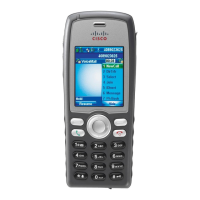DescriptionStatic Setting
Identifies the gateway that provides connectivity to the IP network beyond
the subnet to which the phone belongs.
Default Router 1
If the system is configured to use hostnames for servers instead of IP
addresses, identifies the primary and secondary DNS server to resolve
hostnames.
DNS Server 1
DNS Server 2
Identifies the TFTP servers that the phone uses to obtain configuration files.TFTP Server 1
TFTP Server 2
Voice Communication Security in WLANs
Because all WLAN devices that are within range can receive all other WLAN traffic, securing voice
communications is critical in WLANs. To ensure that voice traffic is not manipulated or intercepted by
intruders, the Cisco Unified Wireless IP Phone and Cisco Aironet APs are supported in the Cisco SAFE
Security architecture. For more information about security in networks, see http://www.cisco.com/en/US/
netsol/ns744/networking_solutions_program_home.html.
Authentication Methods
The Cisco Wireless IP telephony solution provides wireless network security that prevents unauthorized logins
and compromised communications by using the following authentication methods:
Open Authentication
Any wireless device can request authentication in an open system. The AP that receives the request
may grant authentication to any requestor or only to requestors on a list of users. Communication
between the wireless device and AP could be nonencrypted.
Open Authentication with WEP
This is similar to Open Authentication in the preceding bullet, except with improved security.
Communication between the wireless device and AP use Wired Equivalent Privacy (WEP) keys to
provide security.
Shared Key Authentication
The AP sends an unencrypted challenge text string to any device attempting to communicate with the
AP. The device that requests authentication uses a preconfigured WEP key to encrypt the challenge
text and sends the encrypted challenge text back to the AP. If the challenge text is encrypted correctly,
the AP allows the requesting device to authenticate. A device can authenticate only if its WEP key
matches the WEP key on the APs.
Shared key authentication can be less secure than open authentication with WEP because someone can
monitor the challenges. An intruder can calculate the WEP key by comparing the unencrypted and
encrypted challenge text strings.
Cisco Unified Wireless IP Phone 7925G, 7925G-EX, and 7926G Administration Guide
39
VoIP Wireless Network
Voice Communication Security in WLANs

